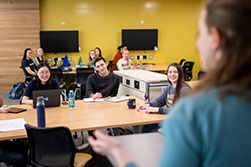CRLT recently published an Occasional Paper by Assistant Director Chad Hershock and U-M Associate Professor of Political Science Mika LaVaque-Manty detailing a range of innovative ways U-M faculty are teaching with Online Collaboration Tools (OCTs). In the coming weeks, we will highlight sections of this paper on our blog, starting this week with ideas from two Thurnau Professors about ways to promote student engagement and participation in large courses. Follow this link to the full paper, including recommendations for implementing OCTs effectively and efficiently in teaching.
 Although students can easily become passive learners in a traditional lecture setting, with the right approach lectures can be a very effective way to disseminate content efficiently to large numbers of students, to present cutting-edge material not available elsewhere, and to model expert thinking. Here are two examples of U-M instructors who have used OCTs in large courses to increase student interactions and engagement.
Although students can easily become passive learners in a traditional lecture setting, with the right approach lectures can be a very effective way to disseminate content efficiently to large numbers of students, to present cutting-edge material not available elsewhere, and to model expert thinking. Here are two examples of U-M instructors who have used OCTs in large courses to increase student interactions and engagement.
a.jpg) Mika LaVaque-Manty, Political Science, teaches lecture courses with 100-300 students and several GSIs. He has used Google OCTs to foster and monitor small group discussions during class, to structure brainstorming with large numbers, and to answer student questions.
Mika LaVaque-Manty, Political Science, teaches lecture courses with 100-300 students and several GSIs. He has used Google OCTs to foster and monitor small group discussions during class, to structure brainstorming with large numbers, and to answer student questions.
- Google docs: Depending on the number of groups and the purpose of the assignment, the whole class may work on a single Google Document, or each group may generate a section or portion of one. In either case, the groupwork creates collectively-produced documents that can be projected for the whole class to debrief together.
- Google Drawings: LaVaque-Manty has used Google Drawings to encourage students to engage in visual brainstorming and concept mapping during class. Instructors can read, comment on, and even grade documents and drawings after class.
- Google Forms: He has also used Google Forms during lectures as a surrogate for personal response systems (e.g., iClickers). To assess student understanding and instigate class discussions, he collects student responses to multiple choice or short-answer questions and display summaries of the data in real-time, leveraging students' laptop computers and smart phones to increase engagement and interactivity.
Follow the link to find full details about how LaVaque-Manty coordinates and manages these activities.
 Robin Queen, Linguistics, lectures to about 150 students in a 300-level linguistics and anthropology course on language and social conflict. To increase student interactions with peers and internet content related to the course, she instituted a blog for each discussion section of 25 students. Queen and her GSIs ultimately used blogger in many ways, including prompting student participation in class discussion, modeling specific writing skills, providing threads for weekly discussion sections, and facilitating student exchanges with one another.
Robin Queen, Linguistics, lectures to about 150 students in a 300-level linguistics and anthropology course on language and social conflict. To increase student interactions with peers and internet content related to the course, she instituted a blog for each discussion section of 25 students. Queen and her GSIs ultimately used blogger in many ways, including prompting student participation in class discussion, modeling specific writing skills, providing threads for weekly discussion sections, and facilitating student exchanges with one another.
Follow the link to find out in detail about how Queen uses and manages the blog activity. Click below to watch a brief video of Queen discussing her use of blogging in this course.
>
For more on innovative use of OCTs in U-M classrooms, click on the OCT tag below.
- Log in to post comments
- 75 views






